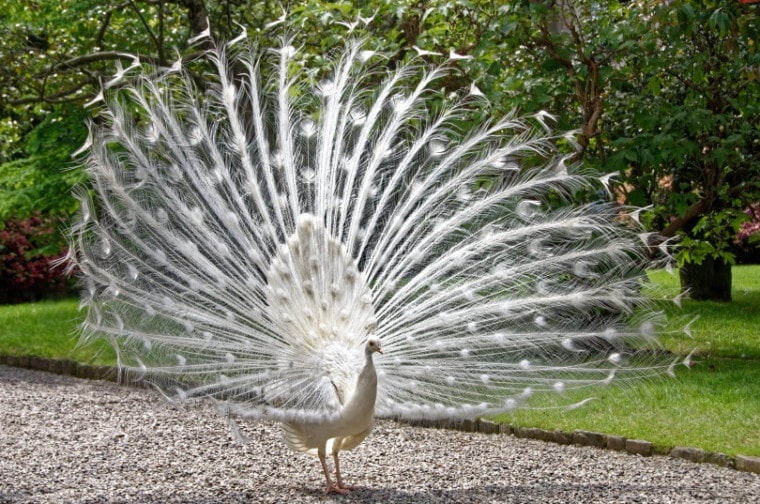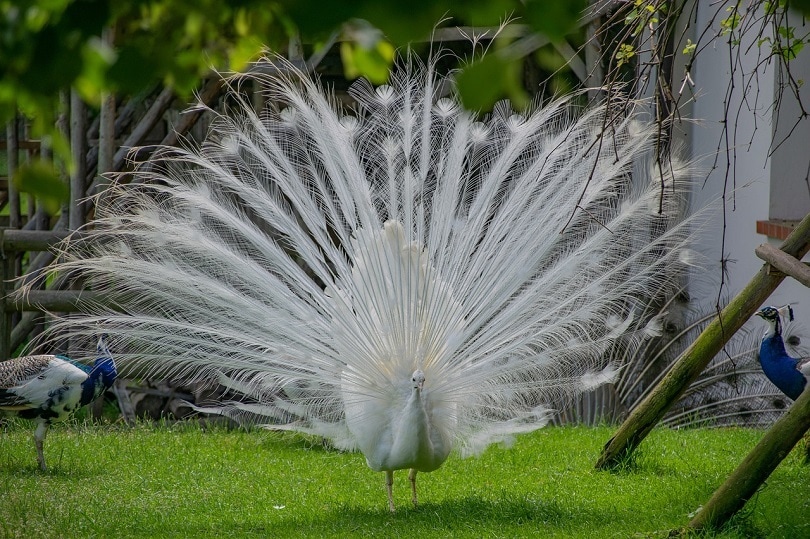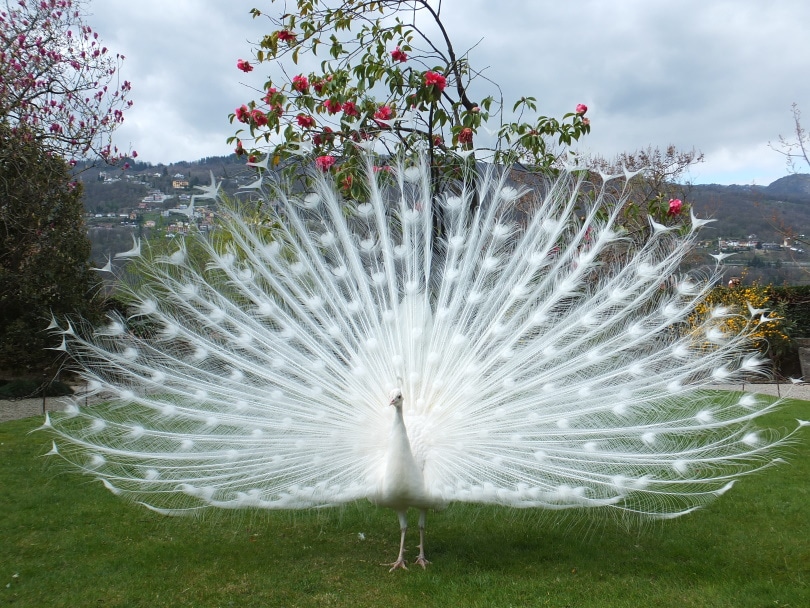
Peacocks are gorgeous animals, with beautiful, elegant plumage and dazzling colors. Rarely, though, you’ll find peacocks without any colors, though they’re beautiful all the same. These birds are known as White Peacocks.
The White Peacock is not a separate breed of peafowl but is a peacock that has been born all-white due to a unique genetic variation. That said, White Peacocks are not albinos either, as albinos have a complete lack of pigment and so have very pale skin and usually red or pink eyes. White peacocks typically have blue eyes and skin with pigment.
The White Peacock is a beautiful, rare, and eye-catching animal. Read on to find out more about this unique peacock variation!
Quick Facts About White Peacocks
| Breed Name: | Pavo cristatus |
| Place of Origin: | India |
| Uses: | Pest control, pets |
| Male Size: | 39–45 inches |
| Female Size: | 37–40 inches |
| Color: | White |
| Lifespan: | 10–25 years |
| Climate Tolerance: | Tropical |
| Care Level: | Moderate |
White Peacock Origins
The Indian Blue Peacock—the breed from which the White Peacock originated—is as the name suggests, native to India. After the British invasion of India, peafowl began to spread throughout Europe and America. White Peacocks may have appeared before this time, but the first recorded White Peacocks appeared in the 1830s.
There are no recorded White Peacocks in the wild, and the color variation only occurs in captivity. This is likely because white coloring in the wild would attract predators, and the recessive gene thus only emerged in the relative safety of captivity.

White Peacock Characteristics
White Peacocks are no different than Indian Blue Peacocks apart from their unique coloring. Males typically reach 39–45 inches in height, while females are slightly smaller at 37–40 inches. In captivity, these peafowls can easily live up to 25 years or more in some cases. The peacocks have the characteristic long and decorative tail feathers, also known as coverts. These make up more than 60% of their total body length and can take up to 3 years to grow. Peahens do not have these decorative tails but still typically have beautiful coloring all the same.
Peafowl are docile animals overall and rarely attack other birds or humans. However, they can be highly territorial at times, especially the peacocks, and can get aggressive when protecting a nest of eggs and will attack other males during mating season when competing for females. Peahens are known to be noisy too and have a loud, high-pitched call. They are particularly noisy during mating season, especially at night.
White Peacock Uses
Some people keep peafowl for pest control, but they will also consume flowers and other plants in the garden and can swiftly make a mess of your vegetable garden! Typically, peafowl are kept as pets, though some people do eat peafowl meat, which is high in protein, and peahen eggs. Peafowl are not an endangered or protected species in the U.S., so it’s perfectly legal to consume them.
In their native India, Indian Blue peacocks are considered sacred animals, are important in religious Indian traditions, and were declared the national bird of India in 1963.

White Peacock Appearance & Varieties
White Peacocks are uniquely beautiful animals and can be seen in several different variations of white. There are pure-white peacocks, pied white (a combination of white and the typical Indian Blue coloring) black shoulder pied (where there is only white found under the wings and chin of the Indian Blue), and black shoulder, which appears white but is peppered with small black spots.
Contrary to popular belief, White Peacocks are not albinos. Albino animals typically have red or pink eyes and a complete lack of pigmentation in their skin. White Peacocks have blue eyes and do not lack skin pigmentation. White Peacock chicks are born yellow and develop into their white color as they mature. The white coloring of these birds is caused by a genetic mutation called leucism, so only their feathers have a loss of pigmentation.
White Peacock Population, Distribution & Habitat
White Peacocks are rare, and little is known about their current population around the world. That said, all White Peacocks exist in captivity only, and there are an estimated 100,000 Indian Blue peafowl around the world.
- See Also: 3 Most Common Types of Peacocks/Peafowl
Are White Peacocks Good for Small-Scale Farming?
While peafowl can be eaten, they are rarely farmed for food. Peafowl meat is known to be tough, and since peafowl grow slowly, they are not farmed as meat birds. Similarly, peahens only lay five to nine eggs per year, so egg production is not a viable option either.
Generally, peafowl are used for pest control or as pets only.

Final Thoughts
White Peacocks are rare, beautiful birds. They are only found in captivity, and their coloring is caused by a unique genetic mutation that occurs in very few birds. If you’ve ever seen a White Peacock, count yourself extremely lucky, as these are unique animals indeed!
See also:
Featured Image Credit: Piqsels







